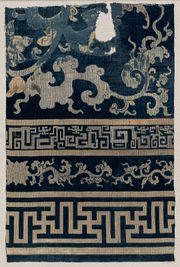Difference between revisions of "Carpet"
| Line 4: | Line 4: | ||
A thick heavy floor covering. Carpets are made from [[wool]], [[silk]], or [[synthetic fiber|synthetic fibers]]. Famous carpet making centers include Turkey, Iran, Afghanistan, India and China. Major European factories were founded in Brussels and Kidderminster. Early rugs were flat-woven; by the 14th century, hand-knotted pile rugs with a backing system were introduced in Asia. The types of knots used are characteristic of their region of production. Looms for weaving carpet were first patented in England in 1749 and by the early 19th century, machine-tufted rugs were commercially available. Until the 1960's most rugs were made from wool, but by 1980, most machine-made carpets were composed of synthetic fibers, such as [[nylon fiber|nylon]] ([[Antron|Antron®]]), [[polypropylene fiber|polypropylene]] ([[olefin fiber|olefin]]), [[polyester fiber|polyester]], [[acrylic fiber|acrylic]] ([[Orlon|Orlon®]]), and [[saran fiber|saran]]. As of 1999, most carpets are made from nylon; it offers wear resistance and resiliency but must be treated to improve stain resistance and decrease static charge. Polyester is soft and easily cleaned but does not wear as well as nylon. Acrylic feels like wool and has low static electricity. Olefin is strong and durable; it is used in indoor outdoor carpets. | A thick heavy floor covering. Carpets are made from [[wool]], [[silk]], or [[synthetic fiber|synthetic fibers]]. Famous carpet making centers include Turkey, Iran, Afghanistan, India and China. Major European factories were founded in Brussels and Kidderminster. Early rugs were flat-woven; by the 14th century, hand-knotted pile rugs with a backing system were introduced in Asia. The types of knots used are characteristic of their region of production. Looms for weaving carpet were first patented in England in 1749 and by the early 19th century, machine-tufted rugs were commercially available. Until the 1960's most rugs were made from wool, but by 1980, most machine-made carpets were composed of synthetic fibers, such as [[nylon fiber|nylon]] ([[Antron|Antron®]]), [[polypropylene fiber|polypropylene]] ([[olefin fiber|olefin]]), [[polyester fiber|polyester]], [[acrylic fiber|acrylic]] ([[Orlon|Orlon®]]), and [[saran fiber|saran]]. As of 1999, most carpets are made from nylon; it offers wear resistance and resiliency but must be treated to improve stain resistance and decrease static charge. Polyester is soft and easily cleaned but does not wear as well as nylon. Acrylic feels like wool and has low static electricity. Olefin is strong and durable; it is used in indoor outdoor carpets. | ||
| − | [[File: | + | [[File:MFA16302 Carpet.jpg|thumb|Chinese carpet<br>MFA# 16.302]] |
== Synonyms and Related Terms == | == Synonyms and Related Terms == | ||
Latest revision as of 10:46, 5 December 2020
Description
A thick heavy floor covering. Carpets are made from Wool, Silk, or synthetic fibers. Famous carpet making centers include Turkey, Iran, Afghanistan, India and China. Major European factories were founded in Brussels and Kidderminster. Early rugs were flat-woven; by the 14th century, hand-knotted pile rugs with a backing system were introduced in Asia. The types of knots used are characteristic of their region of production. Looms for weaving carpet were first patented in England in 1749 and by the early 19th century, machine-tufted rugs were commercially available. Until the 1960's most rugs were made from wool, but by 1980, most machine-made carpets were composed of synthetic fibers, such as nylon (Antron®), polypropylene (olefin), polyester, acrylic (Orlon®), and saran. As of 1999, most carpets are made from nylon; it offers wear resistance and resiliency but must be treated to improve stain resistance and decrease static charge. Polyester is soft and easily cleaned but does not wear as well as nylon. Acrylic feels like wool and has low static electricity. Olefin is strong and durable; it is used in indoor outdoor carpets.
Synonyms and Related Terms
rugs; tapete (Esp., Port.); alfombra (Esp.); tapis (Fr.); vloerkleed (Ned);
Risks
Wool carpeting may emit sulfur containing gases. Carpets may contain active infestations
Additional Images
Resources and Citations
- M.Roberts, "Carpet", The Dictionary of Art Grove's Dictionaries, Inc., New York, 1996.
- R. J. Gettens, G.L. Stout, Painting Materials, A Short Encyclopaedia, Dover Publications, New York, 1966
- Hoechst Celanese Corporation, Dictionary of Fiber & Textile Technology (older version called Man-made Fiber and Textile Dictionary, 1965), Hoechst Celanese Corporation, Charlotte NC, 1990
- Tom Rowland, Noel Riley, A-Z Guide to Cleaning, Conserving and Repairing Antiques, Constable and Co., Ltd., London, 1981
- Pam Hatchfield, Pollutants in the Museum Environment, Archetype Press, London, 2002




